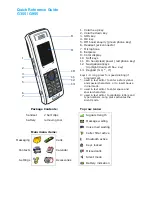
Index
155
(body measurements differ among phone models, depending upon available accessories and FCC
requirements).
While there may be differences between SAR levels of various phones and at various positions, they all
meet the government requirement for safe exposure. The FCC has granted an Equipment Authorization
for this model phone with all reported SAR levels evaluated as in compliance with the FCC RF emission
guidelines. SAR information on this model phone is on file with the FCC and can be found under the
Display Grant section of
http://www.fcc.gov/oet/ea/fccid/
FCC ID
ZNFLS991
.
To find information that pertains to a particular model phone, this site uses the phone FCC ID number
which is usually printed somewhere on the case of the phone. Sometimes it may be necessary to remove
the battery pack to find the number. Once you have the FCC ID number for a particular phone, follow the
instructions on the website and it should provide values for typical or maximum SAR for a particular
phone. Additional information on Specific Absorption Rates (SAR) can be found on the Cellular
Telecommunications Industry Association (CTIA) website at
*In the United States and Canada, the SAR limit for mobile phones used by the public is 1.6 watts/kg
(W/kg) averaged over one gram of tissue. The standard incorporates a substantial margin of safety to
give additional protection for the public and to account for any variations in measurements.
FCC Notice
Part 15.19 statement
This device complies with Part 15 of the FCC rules. Operation is subject to the following two conditions: (1)
This device may not cause harmful interference. (2) This device must accept any interference received,
including interference that may cause undesired operation.
Part 15.21 statement
Change or Modifications that are not expressly approved by the manufacturer could void the
user‘s
authority to operate the equipment.
Part 15.105 statement
This equipment has been tested and found to comply with the limits for a class B digital device, pursuant
to Part 15 of the FCC Rules. These limits are designed to provide reasonable protection against harmful
interference in a residential installation. This equipment generates uses and can radiate radio frequency
energy and, if not installed and used in accordance with the instructions, may cause harmful interference
to radio communications. However, there is no guarantee that interference will not occur in a particular
installation. If this equipment does cause harmful interference or television reception, which can be
determined by turning the equipment off and on, the user is encouraged to try to correct the interference
by one or more of the following measures:
●
Reorient or relocate the receiving antenna.
●
Increase the separation between the equipment and receiver.
●
Connect the equipment into an outlet on a circuit different from that to which the receiver is
connected.
Summary of Contents for LS991
Page 1: ...LS991 User Guide ...
















































